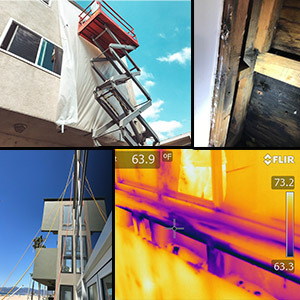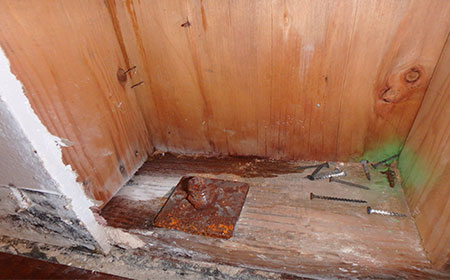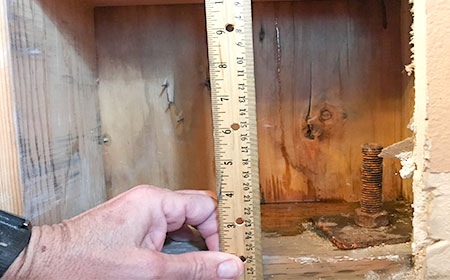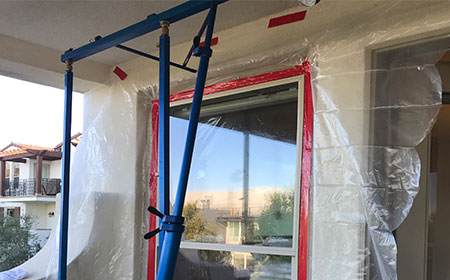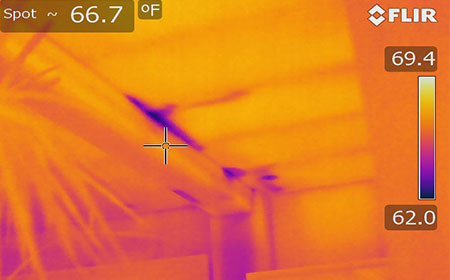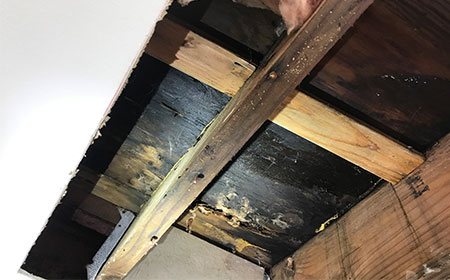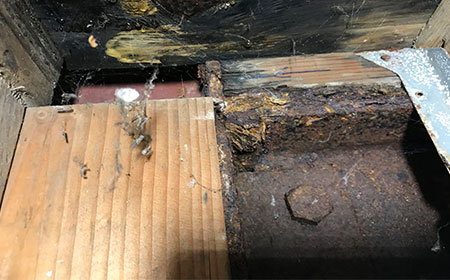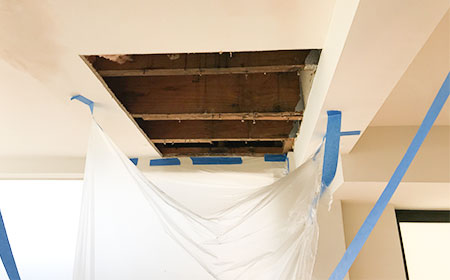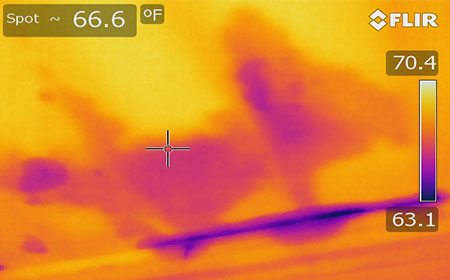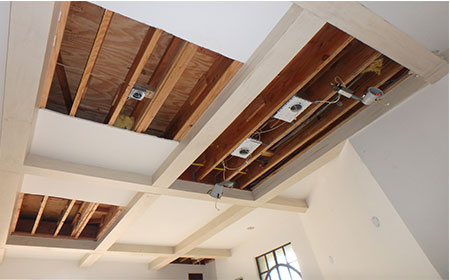AAMA 511 – Forensic water leak detection

In essence, the whole purpose of diagnostic testing is to recreate leaks which are known to occur in specific locations. The biggest difference between the AAMA 511 and the AAMA 502 and AAMA 503 standards is that these tests are performed on newly installed fenestration products for quality assurance testing. Note that AAMA 511 Forensic water intrusion testing is performed on existing window, door or skylight products.
However, the AAMA 511 is much more than just a simplistic Forensic Water Intrusion and Leak Detection guide. For example, the guideline is built around the ASTM E2128 test methodology by adding additional input and insight which can be used to help identify water intrusion into Los Angeles buildings. Simply searching for “Forensic water intrusion inspections in Los Angeles” isn’t enough. Having a company that is qualified and experienced in water intrusion and rain leak detection is essential in determining the cause of the water infiltration. Because of this, not just anyone will do. You need a water intrusion specialist who is truly an expert in their craft and who is laboratory trained in the installation and performance of windows, doors, and wall assemblies.
Furthermore, the AAMA guide allows for the assistance in choosing the appropriate adaptations to the already existing standards in order to apply them to field testing for water intrusion and forensic water leak investigations.
The AAMA 511, when added to the ASTM E2128, provides supplemental assistance. Additionally, it outlines required actions or necessary steps to take in the investigation. In other words, locating window and door product leaks from wall leaks, etc. Forensic water intrusion is just as much an art as it is a science, and the Test Company that has the most experience, training and expertise will be the best for the job.
Forensic Water intrusion
Window Leak Detection
According to Ken Brenden, AAMA technical standards manager… “The newly created document establishes the requirements for field test specimens, apparatus, sampling, test procedures and test reports.” Which is the AAMA 511-08. It’s built on the already seven steps of forensic analysis established in the ASTM 2128, the Standard Guide for evaluating water leaking through stucco or building walls.
In fact, the main objective of Forensic water leak detection is to identify leak paths through simulation of previous weather events which are known to have produced leakage.
As previously mentioned, the AAMA 511-08 adds additional steps to help aid in the investigative process. More specifically, as stated in the guideline, these steps include;
- 3.2.1 Obtain if possible, architectural and structural drawings which will explain how the buildings envelope was intended to have been constructed
- 3.2.2 If possible, gather necessary product specifications of any fenestration products installed
- 3.2.3 Review previous test or other inspection reports such as the 502 or 503 for example
- 3.2.4 Request and view fenestration shop drawings which will show details of the fenestration assemblies
- 3.2.5 Interview Building Staff who may have intimate knowledge of current and or previous leaks and water intrusion patterns
- 3.2.6 Look for water intrusion patterns in areas of the suspected water intrusion as well as on adjacent wall surfaces for the interior and exterior of the building.
Water leak Detection and Post Testing
- Analyze the testing performed and its outcome
- Report on findings derived from window or wall leak testing
The primary goal is Forensic Water intrusion

Above all, the primary goal of the AAMA 511-08 Forensic water leak detection is to recreate leaks which occurs in buildings, while in use. In a nutshell, this is accomplished though research and the simulation of similar weather events though to have contributed to the water intrusion.
First thing to remember is that discovery is pivotal in the process of understanding the how, when, where and why leaks occur in building window products. Not only does the AAMA 511-08 Forensic water leak detection follow the ASTM 2128. Because of its thoroughness, it adds seven preparatory steps to be taken prior to the application of water as well as the post test measures.
Above all, all of the discovery steps are designed to develop a hypothesis for sourcing the window leaks or moisture intrusion.
For one thing, historical weather data must be obtained in order to simulate actual weather events. Indeed, this is accomplished by calculating the differential or negative air pressures which the existing window, door or skylight products may have experienced during real rain and wind occurrences. Afterwhich, these figures (calculated pressures) determines the test pressure used during the recreation testing period.
A break-down of the procedural steps in performing the 511-08 here in Los Angeles

Initially, when approaching an AAMA 511-08 water intrusion analysis, the steps taken in the beginning will more or less set the tone for the entire test. The more energy you place into the research and interrogatory portion of the test the more effective and thus, the better test results will be.
Review of project documents
- Shop drawings
- Fenestration installation instructions
- Architectural Drawings
Evaluation of the component
- Flashings
- Sealants
- Weep holes
Service history
- Maintenance records
- Interview personnel
- Leak history research
Forensic Water intrusion Inspection
- Observe interior for leak patterns
- Exterior observations for leak patterns
- Looking for product deficiency
- Attempt to develop a hypothesis for possible source of water intrusion
Determine the appropriate Forensic Water intrusion test based on:
- Standards
- Prior testing
- Historical weather data
- Experience
Recreating the leak
- Need to know how long to run the test
- Whether or not to include a pressure differential
- How much air pressure
During the test
- Testing with no differential pressures
- Applying differential pressure
- Working from the bottom to the top
- Using isolation to test product vs. installation
- Keeping water on even if leak is discovered
- Identify leak path
- Destructive testing may be necessary
Common issues to overcome
- Limited history regarding leak
- Incorrect hypothesis or theory as to what is leaking
- No water pressure
- Owner does not concede to destructive testing
- Limited accessibility to wall cavities
Reporting
- Reports state factual information, no opinion
- All fact substantiated by genuine results
- The reports should document test performed as well as all percent information regarding results and how they were discovered
Sill Damaged Test is still Forensic Water intrusion
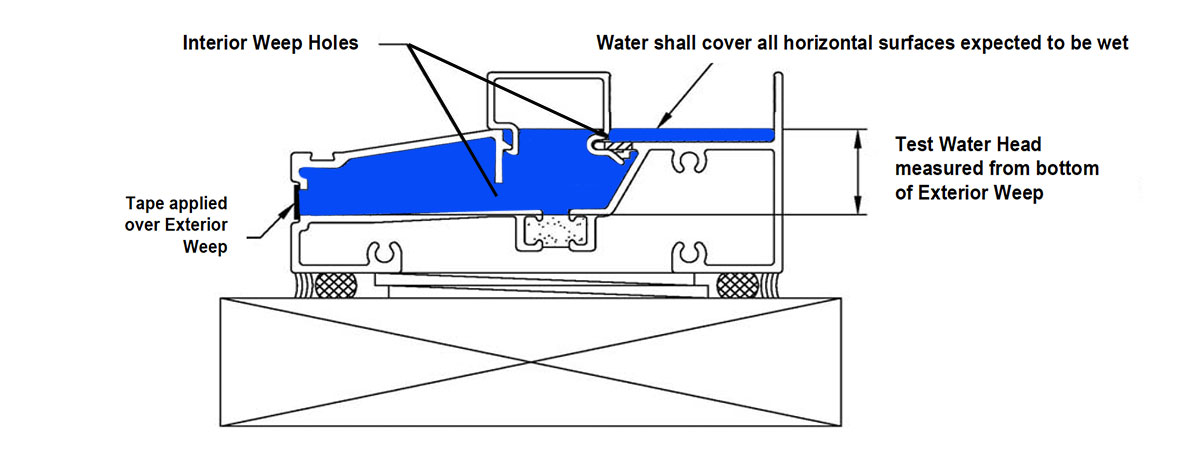
Whenever a window or wall leak is thought to be directly related to a defective window product, the optional AAMA 511 sill damaged test can be performed. Although an easy test, it still must demand the same respect as does AAMA 511-08 Forensic water penetration testing or any other AAMA or ASTM fenestration test performed. For the most part, the test goes something like this;
- At the base of the existing window, door or skylight product, the sill or receptor is filled with water for 15 minutes
- All of the weep holes within this pan are blocked
- A dam is installed at the exterior side to hold the required depth of water within the pan
- The water heigh is determined by the amount of pressure the particular fenestration product is rated for
For example: If one inch of water is equal to 5.20 psf, and the fenestration product is rated for 6.5 psf, the water height is approximately 1.25″. Most cases, however, the fenestration product is tested at 2/3 of its rated design pressure, which is the pressure specified in the field for testing.
During the sill dam test
Once the necessary water depth is achieved, we then monitor the specimen for any water leakage. In most cases, the interior drywall is removed to allow for a visual evaluation. There are other way to detect water intrusion within the ASTM 2128 however.Moreover, it’s worth noting that the AAMA 511-08 sill dam test subjects the existing window, door or skylight product to a greater water exposure than whats considered to be a normal weather event. Because of this, the AAMA 511-08 shouldn’t be the only measure by which you determine whether or not the fenestration product is defective.
